Yamaha TMAX 560 Tech MAX Scooter Review (2020)
Visordown tests out the reworked Yamaha TMAX 560 Tech Max scooter in Estoril, Portugal; Here’s what we make of the more powerful and sportier TMAX.

Yamaha invited us to Estoril, Portugal, to put the new TMAX Tech MAX through its paces. It turns out even in the cold and wet the new A2 licence friendly 2020 TMAX gives you plenty to smile about.
The TMAX has long stood at the top of the maxi-scooter plinth and can be put into the same vein as the (in)famous Lotus Carlton in terms of kudos and respect. After a full day of riding - in every weather condition imaginable - here’s our review of the 2020 TMAX Tech MAX scooter.
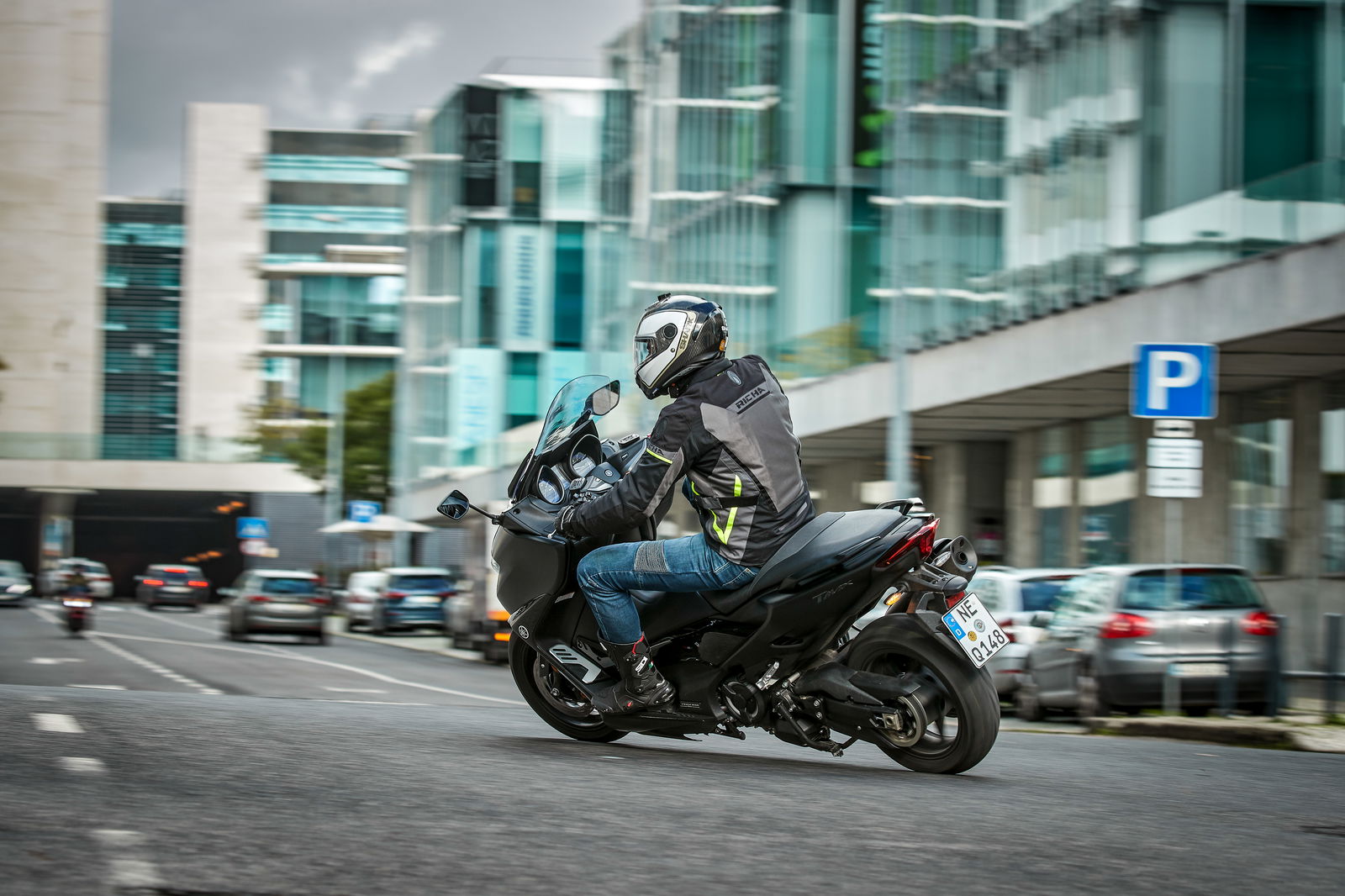
What’s new on the 2020 TMAX?
From the front it looks like business as usual, but the new TMAX is sporting new front LED headlights with DRL’s; new LED blade indicators; new side panels; a redesigned rear end (with singular LED T shaped rear light); more under-seat storage (one full-face or two open-face lids) and some stiffer/sportier suspension.
Under the new skin, the TMAX has had major engine work, making it the most powerful TMAX to date - increasing power to 47bhp with torque being increased by 6.5%.
Price and colours
• Standard model available in Icon Grey & Sword Grey: £10,199
• Premium Tech Max model available in Tech Camo and Sword Grey: £11,649
TMAX Tech MAX
The scooter I rode was the top of the range Tech MAX model. It still rides the same as the base model, but you get some additional extras, such as:
• Gold-coloured fork stanchions
• Adjustable electric screen
• Cruise control
• Heated grips and heated seat
• Adjustable rear suspension (preload)
• MyTMAX Connect app interactivity
All the techy goodies were put to good use as I razzed up a Portuguese mountain in what can only be described as a light monsoon. I must have displeased the weather Gods in a previous life.
Engine
The upgraded 562cc parallel-twin motor helped to effortlessly pull us up plenty of steep inclines. The power and torque increase is thanks to a 2mm larger cylinder bore (70mm), new light-weight aluminium piston, bigger valves and a reworked exhaust system (with 20% thinner steel). The end result is an A2 friendly 47bhp which has 6.5% more torque [55.7 Nm @ 5250 rpm] and 3.5% more power. And, as is the thing in 2020, it’s EU5 compliant - achieving a claimed fuel consumption 4.7l per 100km. Although not scientific, I clocked 247.7km - which included some very spirited riding - and still had one bar of fuel left on the dash, which equates to 60-90km of range left. Not too shabby, right?
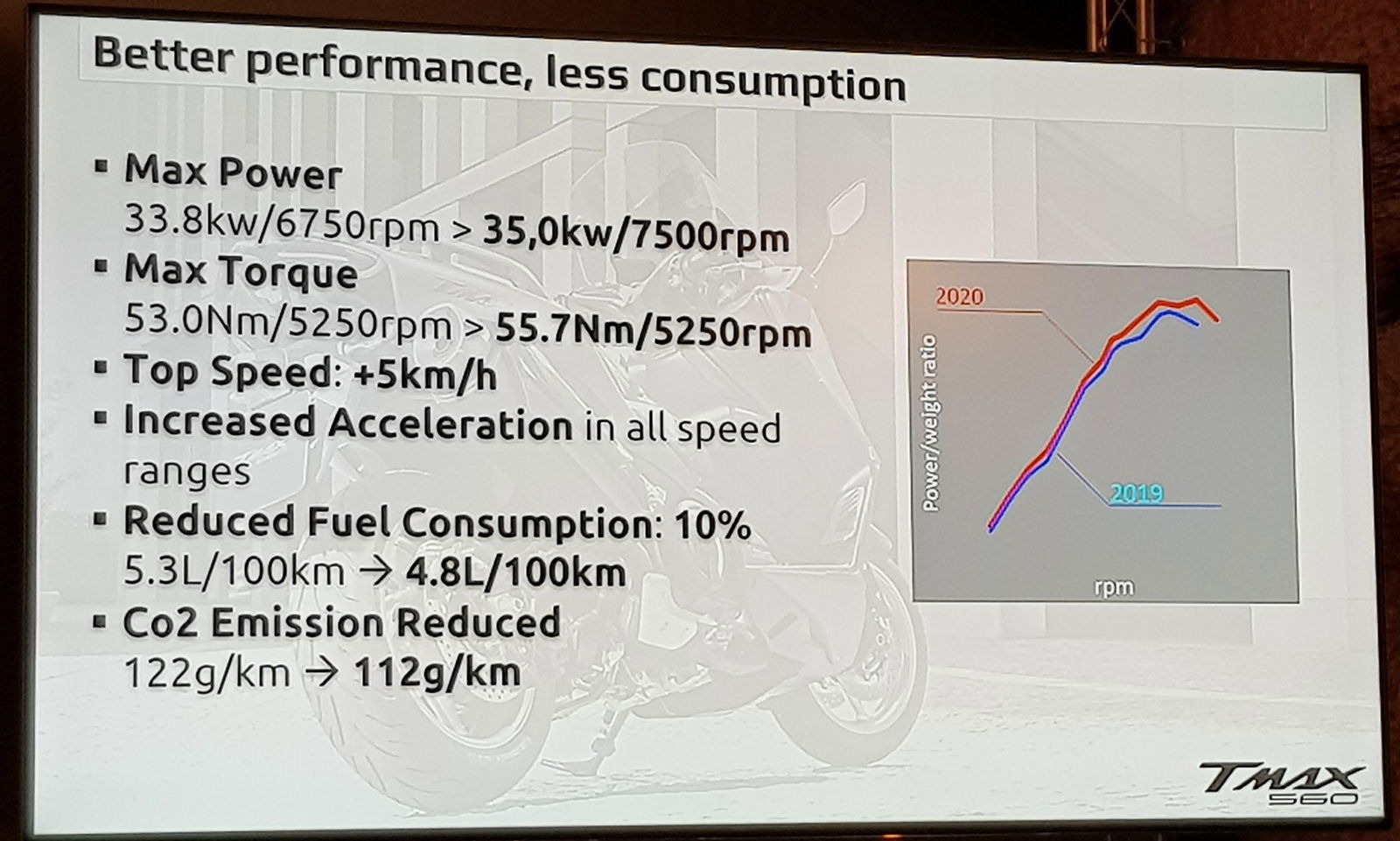
The amount of power supplied to the rear wheel via a CVT belt drive is perfect for real-world conditions, at no point was I left wanting more. On faster country lanes passing slower-moving vehicles is a breeze, and the whoosh of torque can be felt as the engine kicks into life at around 3,000rpm onwards. Granted, you have to give it a wrist full, but this is all part of the fun on medium capacity machines.
The throttle connection is great, certainly up there with one of the best I’ve ever felt on a scooter. It’s direct and accurate even at sub 5mph speeds and low revs - which greatly aides slow-speed manoeuvrability. The engine response is good too, twisting the throttle gives you plenty of boot in the right gear whenever required, and it’s rapid from a set of lights. In sports mode, the throttle response is slightly more urgent than touring, but both modes are still silky smooth and offer the full 47bhp.
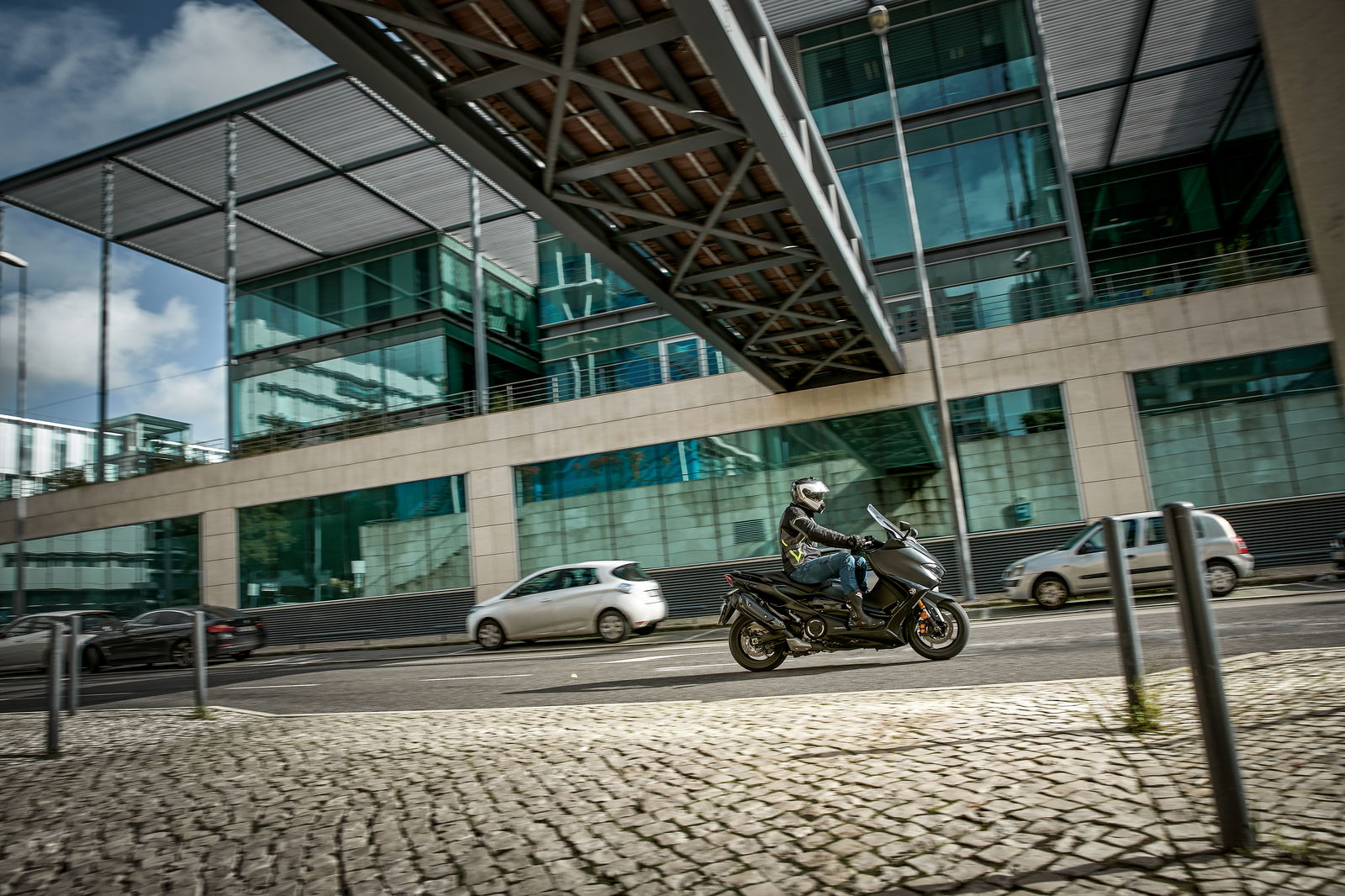
It’s in town that this motor shines. Its smoothness and urgency gives the rider an empowering sense of confidence and encourages swift [yet legal] urban style riding - which is fun as heck! And it sounds alright too.
Chassis and Suspension
The gruntier power unit is a stressed member of the twin-spar aluminium frame and the suspension has received stiffer spring to improve handling, which offers a light and agile handling character - something the TMAX is already well-known for.
At the front, there’s a set 41mm USD forks (non-adjustable) and at the rear, there’s a mono-cross single rear shock (preload adjustable). The whole package is firmer than the 6th generation TMAX and it seemed to handle the bump ridden roads of Estoril very well - only being upset by some dilapidated and mega sketchy tram lines in the city of Lisbon.

Handling
It’s no secret that the old TMAX handled well; The new 560 is no different. In wet and dry conditions the 15” Bridgestone tyres offer a good amount of feedback and lean, and if you’re a real boss you’ll scrape the centre stand no sweat – not that this is advised...
Despite the long 1575mm wheelbase, the TMAX handles incredibly well. It’s stable through long sweepers but nimble at slower speeds, with light steering to match. Along the mountain switchbacks, it’s easy to forget you’re riding a 222kg scooter. The 52% rear weight bias and smooth torque delivery makes the TMAX very rewarding to hustle, particularly in town. The flickabilty, stability and grunt all add up to a filtering beast of a maxi-scooter.
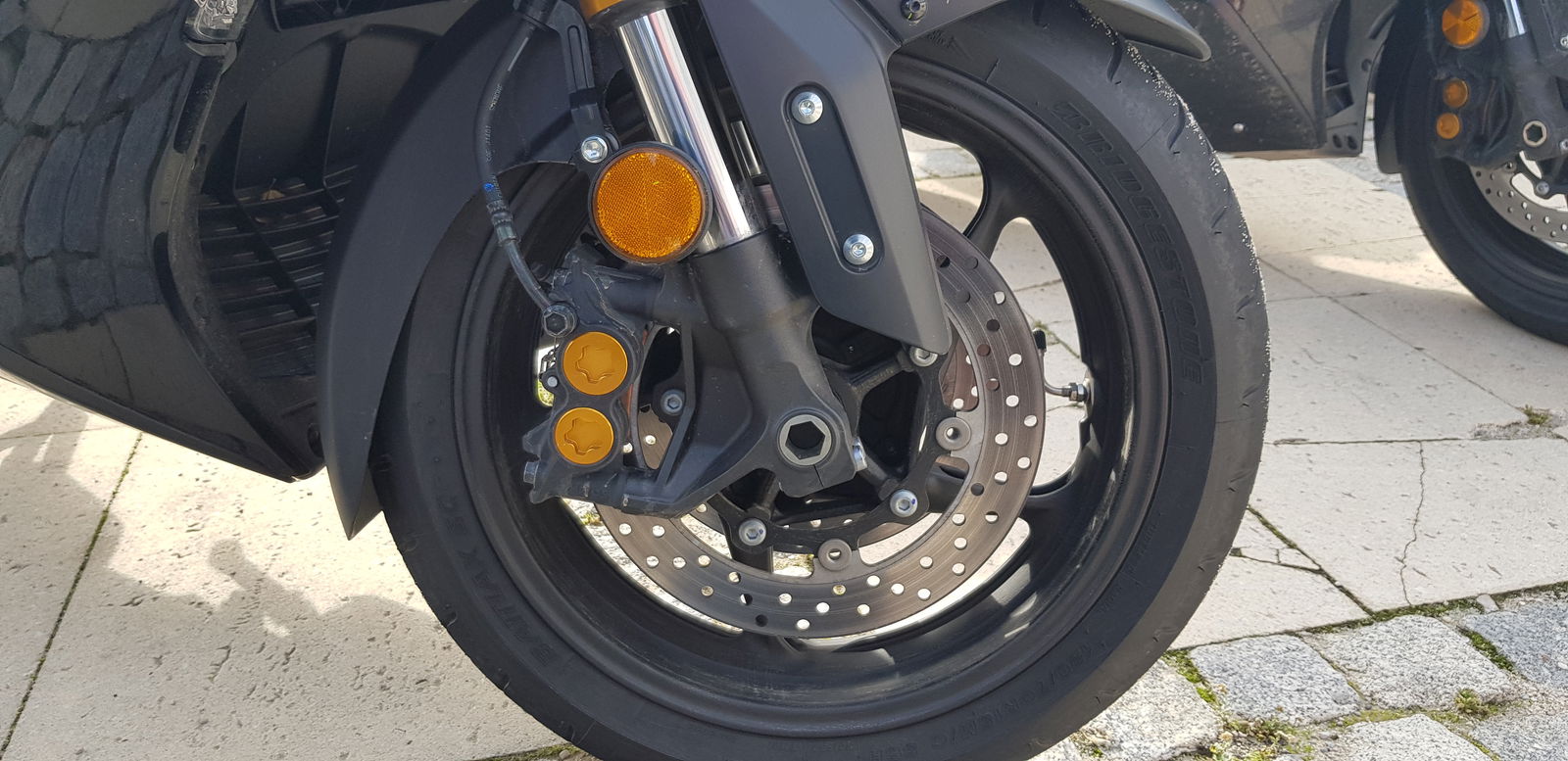
Brakes
Up front the TMAX is equipt with two four-piston calipers chomping down on dual 267mm discs. The rear has a single-piston unbranded caliper matched with a 282mm disc – with a cable operated parking brake attached above.
The brake levers have 5 adjustment positions and require an affirmative two-finger pull to get the bike stopped at a good rate of knots. It’s an adequate package, which doesn’t unsettle the scooter, but perhaps it could do with a bit more initial bite (swapping the pads would achieve this). ABS is fitted as standard.

Ergonomics/Comfort
The seat, although only 800mm tall, is still quite wide, having that ‘man spread’ vibe about it. Fine for lanky buggers like me, but will likely result in tippy toes for the shorties out there. However, for the passenger, ground access has been improved with a thinner rear seat and tail section.
The electronically adjustable screen is a great addition to the Tech MAX. Extending this puppy up to maximum offers impeccable wind protection and reduces the wind noise greatly. Over a mega gusty bridge heading out of Lisbon, I raised the screen up and alas, no more buffeting and feeling like you helmets going to take flight. Touché Yamaha, touché.

TMAX Equipment as standard
Yamaha D-MODE electronic control technology |
Traction control (improved) |
ABS |
2 riding modes: Touring and Sport |
Monotone TFT dash |
Smart key (keyless) ignition & centre stand locking system |
Switching between riding modes is done easily on the fly at the touch of a button, and adjusting the Tech MAX’s features e.g. heated grips and screen is also intuitive. My only gripe is that the up/down selector button is in an obscure location and not easily reached with your left hand on the handlebar – even with my abnormally long thumb.
We like:
• Handling stability at high speed
• Low-speed manoeuvrability
• The urgency of power delivery and torque
• Good under-seat storage
We don’t like:
• Firm seat
• Position of left-hand switchgear toggle button (too high)
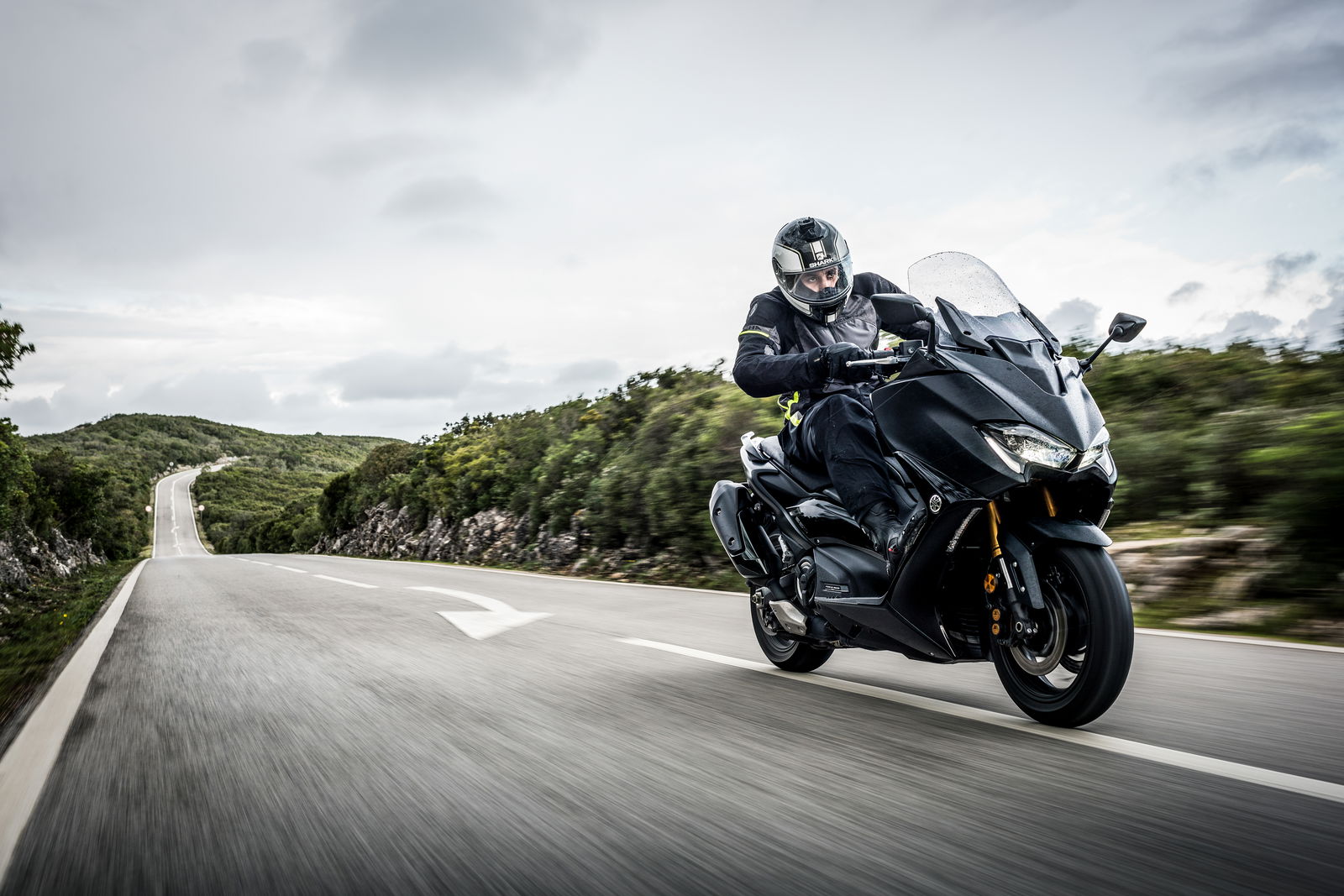
Verdict
It’s always difficult to drastically improve a good recipe, and for this reason, Yamaha has added a little extra spice to the TMAX 560. The firmer suspension does improve the responsiveness of the bike. And this, coupled with the extra power makes for an epic urban and suburban smile factory.
Yes, it’s a fair wedge of cash, but unlike a supersport or super naked machines, you can ride the TMAX day in and day out with impeccable ease, and this makes its cost far more justifiable. Just consider the price of an annual train ticket... chances are you won’t have your own seat during rush hour, let alone a heated one.
The TMAX 560 might not be everyone’s cup of tea and the lack of a gear lever will likely deter the motorcycle purists out there. But for anyone who wants a premium, commutable, two-wheeled hack, with light touring potential - come rain or shine – the TMAX 560 Tech Max is a worthy choice.
TMAX – Technical Specification | |
Engine | |
Type | Parallel 2-cylinder, Liquid cooled, 4-stroke, DOHC, 4-valve |
Displacement | 562 cc |
Bore x stroke | 70.0×73.0 mm |
Compression ratio | 10.9:1 |
Maximum power | 35.0 kW @ 7500 rpm |
Maximum torque | 55.7 Nm @ 5250 rpm |
Lubrication system | Dry sump |
Fuel system | Fuel injection |
Ignition system | TCI/LMAR7G |
Starter system | Electric starter |
Transmission | V-belt automatic |
Fuel consumption | 4.8l / 100 km |
CO2 emission | 112g / km |
Chassis | |
Front suspension | Telescopic fork |
Front Travel | 120 mm |
Rear suspension | Swingarm (link suspension) |
Rear Travel | 117 mm |
Front brake | Hydraulic dual disc brake, Ø267 mm |
Rear brake | Hydraulic single disc brake, Ø282 mm |
Front tyres | 120/70R15M/C 56H Tubeless |
Rear tyres | 160/60R15M/C 67H Tubeless |
Dimensions | |
Overall length | 2,200 mm |
Overall width | 765 mm |
Overall height | 1,420 mm – 1,555 mm (adjustable windscreen) |
Seat height | 800mm |
Wheelbase | 1,575 mm |
Min. ground clearance | 125mm |
Wet weight (including full oil and fuel tank) | 218 kg |
Fuel capacity | 15 L |
Oil capacity | 3.50 L |

